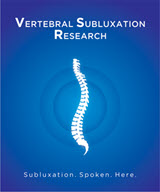New Research on Subluxation Assessment

CLICK HERE to review the research
“Research is revealing that structural shifts in spinal alignment and the nerve obstruction they cause may be a factor in a number of disorders and can result in a host of health problems” stated Dr. Matthew McCoy a chiropractor, public health researcher and editor of the journal that published the study.
McCoy added “If you damage or compress or otherwise interfere with the neurological structures in the spine this can have far reaching implications on the functioning of the body. Through research reports like this we are finding that there are ways to document the correction of the structural abnormalities associated with these spinal problems and reduced nerve obstructions.”
According to researchers the nervous system controls and coordinates all functions of the body and structural shifts in the spine can occur that obstruct the nerves and interfere with their function. By removing the structural shifts, chiropractic improves nerve supply and function. It is this obstruction, called vertebral subluxations, that chiropractors correct.
The purpose of this study was to investigate whether asymptomatic subjects who present in subluxation pattern demonstrate altered sensorimotor control of the cervical spine as compared to asymptomatic subjects who are not in subluxation pattern.
The results of this study indicated that when using distance from center as the assessment variable, patients found to be in supine leg check pattern by either of the two examiners demonstrated statistically significant increased repositioning errors during the CCKST (p = .01). For this cohort, variability of the “in-pattern’ group was significantly higher than those found to not be in supine leg length pattern (p = .03).
Those in the “in-pattern” cohort as noted by either examiner also demonstrated increases in head repositioning errors when considering thermal pattern and both thermal and leg check pattern, as compared to those not in pattern. Similar findings were noted using distance between points on the CCKST test.
The study’s authors called for additional research to investigate the clinical implications of chiropractic in this population.
Contact Information:
Matthew McCoy DC, MPH
Journal of Pediatric, Maternal & Family Health – Chiropractic
http://www.chiropracticpediatricresearch.com
support@vertebralsubluxationresearch.com

Research News
- The 19th International Research and Philosophy Symposium (IRAPS): Bridging Philosophy, Science, and Practice in Chiropractic
- New Study Uncovers the Broad Systemic Benefits of Chiropractic Care on Nervous, Endocrine, and Immune Systems
- The Hidden Power of the Spine: How Vertebral Subluxation Impacts Health Through Systems Biology
- New Study Sheds Light on Vertebral Subluxation and Systems Biology
- Understanding Cervical Spine Movement and Motor Vehicle Accidents













